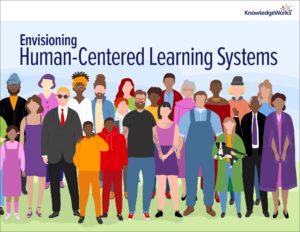As a first-year math teacher, Marissa Schuldheisz is constantly thinking about tweaking and improving her lessons and classroom structures. Schuldheisz teaches at Heritage Middle School in the West Fargo School District, one of four districts in North Dakota partnered with KnowledgeWorks in pursuit of personalized, competency-based learning.
At the beginning of January, Schuldheisz implemented a new approach with her advanced math class. She’s since launched the same structure in her other math course.
- Each class begins with a 15-minute lesson of focused, direct instruction based around a learning target. Students know when to stop Schuldheisz to ensure she doesn’t go over the time limit.
- Students spend the next 25 minutes of class working through different activities that Schuldheisz has prepared on Schoology. They work at their own pace and are allowed to work together as long as they stay on task.
- When students feel ready, they take a self-graded quiz to “check” their learning progress and see if they’re ready to move onto the next learning target.
- At the end of each class period, students take 10 minutes to reflect on their learning for the day. They write out their learning target, list out the activities they completed or attempted, rate themselves on a proficiency scale and leave comments about what they may need help on. This allows Schuldheisz to quickly understand where each student is in their learning and what they need to advance.
“The reflection has been a lifesaver for me, because then I know who to check in with the next day,” she said. “I love that they can tell me what to teach next and I don’t just have to guess. I’m not holding them back or leaving them behind.”
Two years in, these North Dakota districts share milestones reached in pioneering personalized, competency-based learning – and the distance learning challenges.
Read more >
Before students complete a learning unit, they meet with Schuldheisz for a short conference where the student explains how they know that they have reached proficiency and if there’s anything else they need to review. The next step is the “show” process, which is either a project or a test to demonstrate their mastery of the learning targets included in the unit.
Schuldheisz’s colleague, Emily Harrison, has also been implementing conferences in her sixth grade social studies and English/language arts classes. She’s set up a “choice board,” allowing students to choose how they’ll demonstrate their learning. When they’ve completed their project to “show” their learning, they let Harrison know that they’re ready for a conference.
Those conferences last about five to 10 minutes and start out with Harrison asking, “What are you proud of?” She asks a few other growth-mindset questions and has the student reflect on the skills they gained and what they would do differently if they were to repeat the assignment. “Show” projects in her social studies classes have so far included a clay creation of the Parthenon and 3-D printed examples of ancient Grecian technology.
This year marks Harrison’s seventh year as a classroom teacher, but it’s the first year she’s focused more on personalized learning.
“I’ve done the more traditional approach where we’re all at the same pace and the teacher introduces an activity, the student does the activity and everyone turns it in at the same time,” she said. “Compared to that, I’m now seeing so much more ownership and autonomy from my students over what they are learning.”
This guest article was written by Mara Klecker, a journalist in Minneapolis, Minnesota. Klecker is the daughter of two educators and has always called the Midwest home.
Learn why offering students choices is an important part of creating a student-centered classroom and increasing student engagement.




